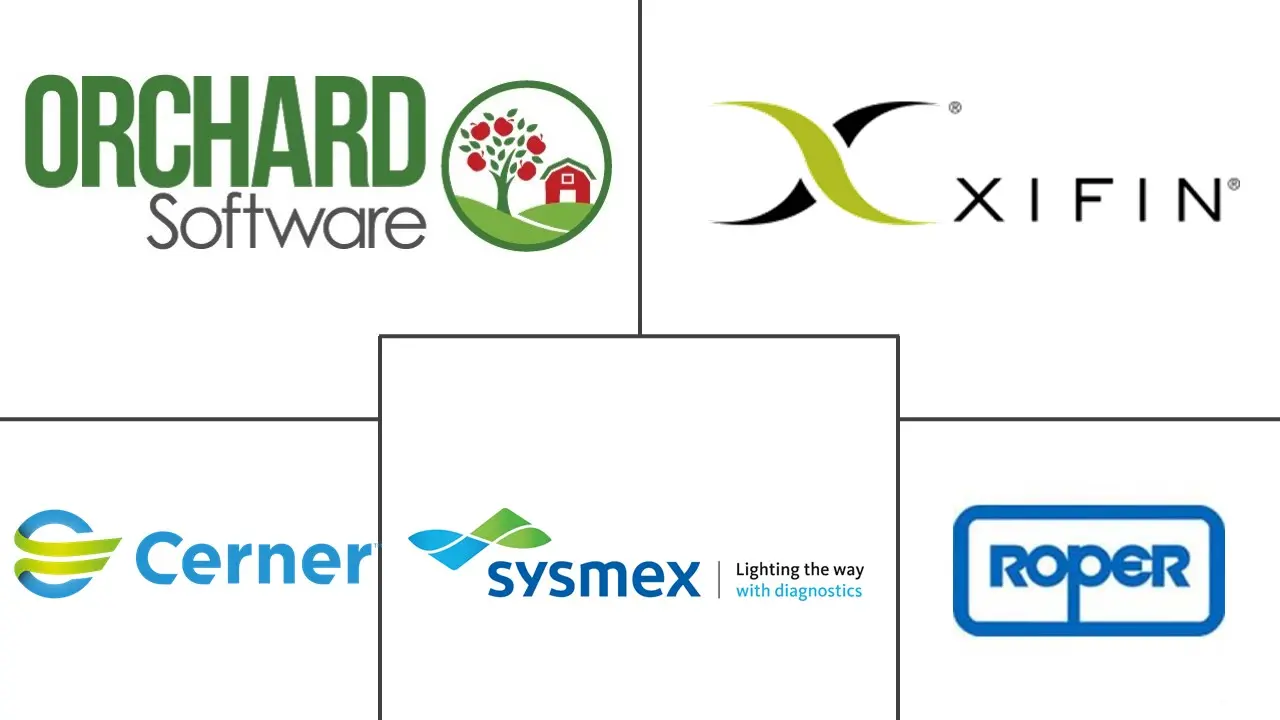Global Laboratory Information System Market Size and Share
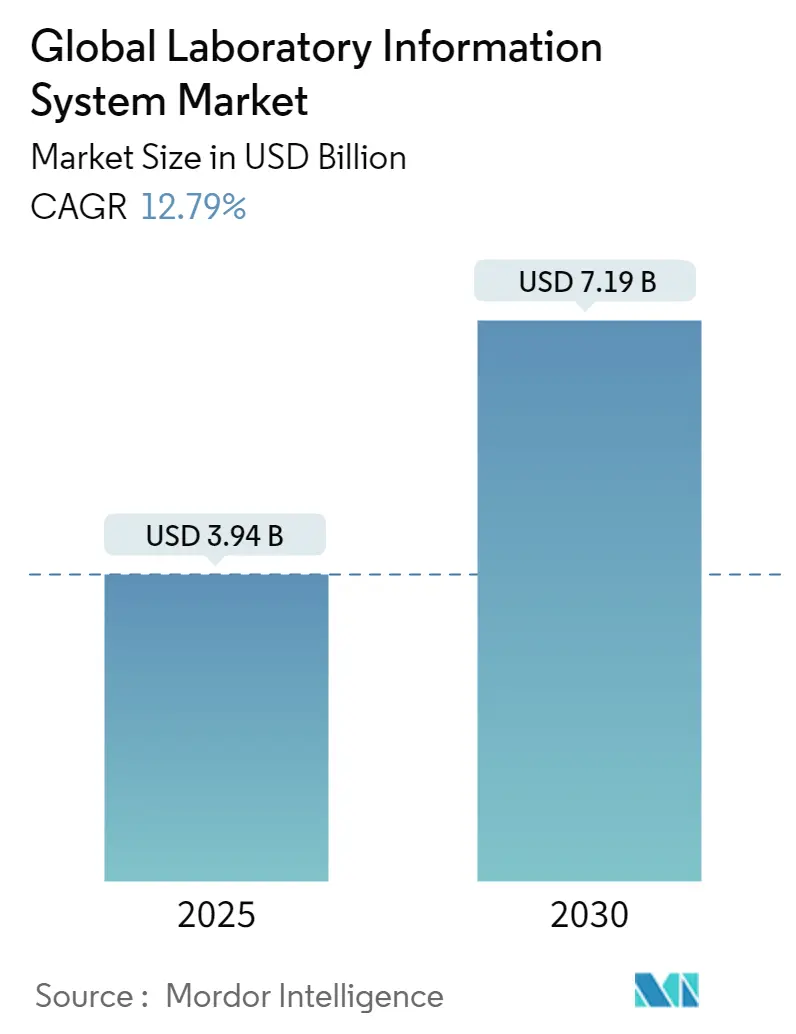
Global Laboratory Information System Market Analysis by Mordor Intelligence
The laboratory information system market is valued at USD 3.19 billion in 2025 and is forecast to climb to USD 7.19 billion by 2030, advancing at a 12.79% CAGR. Growth rests on larger test volumes generated by aging populations, fast-maturing cloud architectures that cut capital barriers, and tightening interoperability mandates that pull laboratories into broader clinical data networks. Software remains the anchor purchase, yet demand leans toward expert services that shorten time-to-value, while AI modules move from pilot to production in result validation, inventory control, and predictive maintenance. Laboratories also recalibrate deployment strategies: most large institutions still run on-premise systems, but small and midsize facilities pivot to software-as-a-service models that open enterprise-grade features without server investments. Geographic momentum shifts as Asia-Pacific adds new digital health budgets and leapfrogs legacy constraints, even while North America guards its lead through rigorous compliance rules and early AI adoption. Escalating cyberattacks underscore the need for zero-trust security layers that strengthen vendor selection criteria, and a wave of mergers—from diagnostics giants to cloud-native entrants—signals a race for scale, talent, and regulatory depth.
Key Report Takeaways
- By component, software retained 65.15% revenue share in 2024 while services are set to expand at a 13.14% CAGR to 2030.
- By mode of delivery, on-premise installations controlled 59.26% of the laboratory information system market share in 2024, yet cloud solutions are projected to accelerate at a 13.85% CAGR through 2030.
- By laboratory type, clinical pathology dominated with 38.7% of the laboratory information system market size in 2024; molecular diagnostics laboratories are positioned for the fastest 13.92% CAGR.
- By end user, hospitals and clinics commanded 55.45% share of the laboratory information system market size in 2024 while independent laboratories lead growth at a 14.12% CAGR.
- By geography, North America led with 42.84% of the laboratory information system market share in 2024; Asia-Pacific records the quickest 14.38% CAGR through 2030.
Global Laboratory Information System Market Trends and Insights
Drivers Impact Analysis
| Driver | ( ~ ) % Impact on CAGR Forecast | Geographic Relevance | Impact Timeline |
|---|---|---|---|
| Rising global diagnostic testing volumes | +2.8% | North America, Europe, expanding worldwide | Long term (≥ 4 years) |
| Rapid scale-up of biobank networks | +1.9% | North America, Europe, emerging Asia-Pacific | Medium term (2–4 years) |
| Uptake of cloud/SaaS LIS | +2.4% | Global, early U.S. adoption | Short term (≤ 2 years) |
| AI-powered workflow automation | +2.1% | Asia-Pacific core, spill-over to North America and Europe | Medium term (2–4 years) |
| Regulatory mandates for interoperability | +1.6% | North America, European Union | Long term (≥ 4 years) |
| Growth of cloud-native LIS start-ups | +1.5% | Asia-Pacific, Latin America, Middle East | Medium term (2–4 years) |
| Source: Mordor Intelligence | |||
Rising Global Diagnostic Testing Volumes Driven by Aging Populations
World health systems process soaring test counts as the 65-plus demographic accelerates, lifting chronic disease panels and routine screenings. In the United States alone, laboratories handled more than 14 billion tests in 2024, and demographic projections indicate sustained expansion. Manual workflows cannot keep pace, so laboratories deploy modern LIS modules that automate specimen labeling, tracking, and multilayer result verification. AI engines now flag hemolysis or clot interference within seconds, releasing technologists for complex review. Rural clinics in China that adopted health kiosk networks saw patient visits jump 37.85% and medical revenue climb 54.03%, illustrating the multiplier effect once digital processes anchor community care [1]BMC Health Services Research, “Impact of Smart Health Kiosks in Rural China,” bmchealthservres.biomedcentral.com.
Rapid Scale-up of Biobank Networks
Precision-medicine projects demand longitudinal biospecimen libraries, pushing biobank consortia to invest in configurable LIS platforms. These systems track consent, lineage, and chain-of-custody across distributed freezers while integrating with sequencing pipelines. Guy’s and St Thomas’ BioResource deployed Matrix Gemini to automate 500,000-plus samples and reclaimed 20% storage space through optimized location mapping. Vendors respond with biobank-ready modules that map sample derivatives, enforce ISO 20387 compliance, and export query-ready data to translational research teams.
Rapid Uptake of Cloud/SaaS LIS That Lower Capital Outlays
Subscription pricing realigns spending from capital to operating budgets. Small independent labs now spin up validated LIS environments in under 30 days via pre-configured instances supplied by vendors such as LabWare, bypassing months of on-premise hardware staging. SOC 2 certifications, end-to-end encryption, and HIPAA-signed business associate agreements calm earlier security doubts. During pandemic surges, cloud customers scaled capacity 3–5× within hours, an elasticity on-premise deployments could not replicate. This agility cements cloud as a default path for greenfield labs and for brownfield migrations once hardware refresh cycles expire.
AI-Powered Workflow Automation Modules
Machine-learning models now execute autoverification on multi-analyte panels, cutting manual release times by 60% while maintaining error-free reporting benchmarks, according to pilots run at Siemens Healthineers partner sites [2]Siemens Healthineers, “Innovation Barometer 2025,” siemens-healthineers.com. Algorithms also forecast reagent depletion and schedule analyzer maintenance before unplanned downtime, shrinking operational costs. Vendors embed natural-language engines that compile clinical interpretations, enabling pathologists to focus on edge cases rather than routine negative findings. These gains shift purchasing criteria toward platforms that prove measurable turnaround-time reductions.
Strengthening Regulatory Mandates for Interoperability
The United States 21st Century Cures Act and the European Union’s EHR exchange framework require discrete, coded results and bidirectional data exchange. Laboratories therefore select LIS that support HL7 FHIR APIs, electronic test ordering, and structured comments compatible with longitudinal patient records. Non-compliance risks reimbursement penalties and lost referrals, making interoperability a board-level priority. Vendors able to certify seamless data transit across hospital networks and public-health registries win sizable contracts.
Restraints Impact Analysis
| Restraint | (~) % Impact on CAGR Forecast | Geographic Relevance | Impact Timeline |
|---|---|---|---|
| High total cost of ownership | -1.8% | Global, particularly affecting smaller laboratories | Short term (≤ 2 years) |
| Escalating cybersecurity & HIPAA/GDPR liabilities | -1.4% | North America & EU regulatory environments | Medium term (2-4 years) |
| Shortage of LIS-literate lab informaticians | -1.2% | Global, with acute shortages in North America | Long term (≥ 4 years) |
| Fragmented and evolving regulatory requirements | -1.0% | Global, with complexity peaks in North America & EU | Medium term (2-4 years) |
| Source: Mordor Intelligence | |||
High Total Cost of Ownership
Comprehensive LIS deployments frequently overrun initial budgets once data migration, validation, and user training surface. Full-scale projects can cross USD 60,000 in software fees and stretch 6–9 months, while annual licensing spans USD 3,000 to USD 250,000 depending on seats and modules. Smaller labs lacking internal IT teams bear integration consulting expenses that double headline price tags. New U.S. FDA rules for laboratory-developed tests from May 2025 introduce additional documentation and quality-system layers that inflate implementation timelines.
Escalating Cybersecurity & HIPAA/GDPR Liabilities
Ransomware assaults surged to 725 reported breaches in U.S. healthcare facilities during 2023, with the February 2024 Change Healthcare attack alone disrupting claims worth USD 6.3 billion. Laboratories must now budget for intrusion detection, zero-trust network designs, and 24/7 security operations centers. The U.S. HHS framework released in December 2023 proposes mandatory cyber practices, and GDPR fines in Europe climb to 4% of annual revenue for non-compliance [3]Department of Health & Human Services, “Healthcare Sector Cybersecurity Strategy,” hhs.gov. These costs divert funds from functional upgrades and lengthen procurement cycles, particularly for cloud deployments that trigger strict data-sovereignty reviews.
Segment Analysis
By Component: Services Surge Despite Software Dominance
Software maintained a 65.15% stake of the laboratory information system market in 2024, anchored by core modules that orchestrate specimen intake, analyzer interfaces, and compliance documentation. Implementation teams, however, observe that successful rollouts hinge on workflow redesign, driving services revenue to a 13.14% CAGR. The laboratory information system market size associated with integrated support bundles is projected to widen as labs outsource validation and post-go-live optimization. SaaS code bases speed version upgrades, yet they also spur demand for training contracts that upskill staff on quarterly releases. Vendors differentiate through consulting depth, interoperability mapping, and regulatory audit readiness, converting one-time license deals into recurring service pipelines.
Second, smaller facilities with lean headcount lean on managed services for server monitoring, patching, and cybersecurity hardening. Premium support tiers bundle 24/7 help desks and rapid interface tailoring as payer rules evolve, creating annuity revenue streams that offset cyclical license spending. With the FDA’s 2025 LDT rule intensifying documentation duties, laboratories look for partners that supply pre-built SOP templates and e-signature workflows, ensuring continuous compliance while internal teams remain focused on quality control tasks.
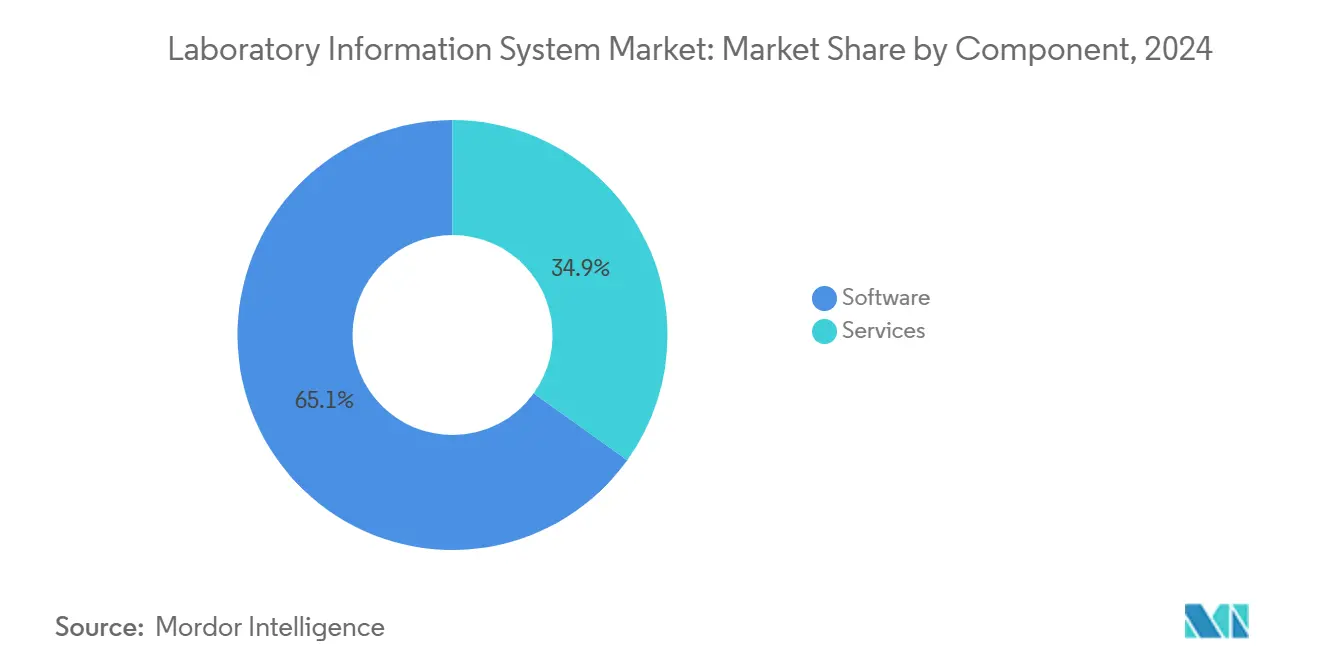
Note: Segment shares of all individual segments available upon report purchase
By Mode of Delivery: Cloud Migration Accelerates Despite On-Premise Dominance
On-premise deployments held 59.26% of the laboratory information system market share in 2024 as large hospitals safeguarded data sovereignty and leveraged sunk server investments. Yet cloud implementations record a 13.85% CAGR, signaling an inflection in buying patterns. The laboratory information system market size attributable to SaaS contracts is forecast to rise sharply as subscription models scale with test volumes rather than hardware cycles. Hybrid approaches emerge where sensitive personally identifiable information resides on-site, while analytics dashboards and long-term archives shift to vendor clouds.
Remote access needs borne out of pandemic restrictions tipped executive sentiment toward cloud reliability, and proof-of-concept pilots now demonstrate parity or superiority in uptime compared with on-premise clusters. SOC 2 Type II reports, HIPAA business-associate assurances, and regional data-residency zones address compliance teams’ concerns. Over time, depreciation schedules and power-cost spikes further erode the economics of maintaining local data centers, accelerating the transition path for institutions planning next-generation smart-hospital blueprints.
By Laboratory Type: Molecular Diagnostics Labs Lead Growth Transformation
Routine clinical pathology still generated the largest revenue of 39.84% in 2024, yet molecular diagnostics laboratories chart the quickest 13.92% CAGR as oncology and rare-disease management pivot to gene-level insights. For this cohort, the laboratory information system market size expands in tandem with high-throughput sequencers that fire terabytes of raw reads per day. Vendors embed bioinformatics pipelines and variant-interpretation engines, consolidating tasks once split across disparate platforms.
Meanwhile, blood banks and biobanks mandate lattice tracking of aliquots and derivative samples, a feature set lacking in many generic LIS offerings. Digital anatomic pathology leverages glass-slide scanners and AI morphology scoring, requiring image-management extensions that interlock with patient folder records. This laboratory diversification presses vendors to verticalize releases, shipping molecular-first, pathology-first, or transfusion-first editions rather than one-size-fits-all bundles. Competitive advantage gravitates to suppliers who pre-load specialty-specific vocabularies, quality-control rules, and reporting templates that slash configuration cycles.
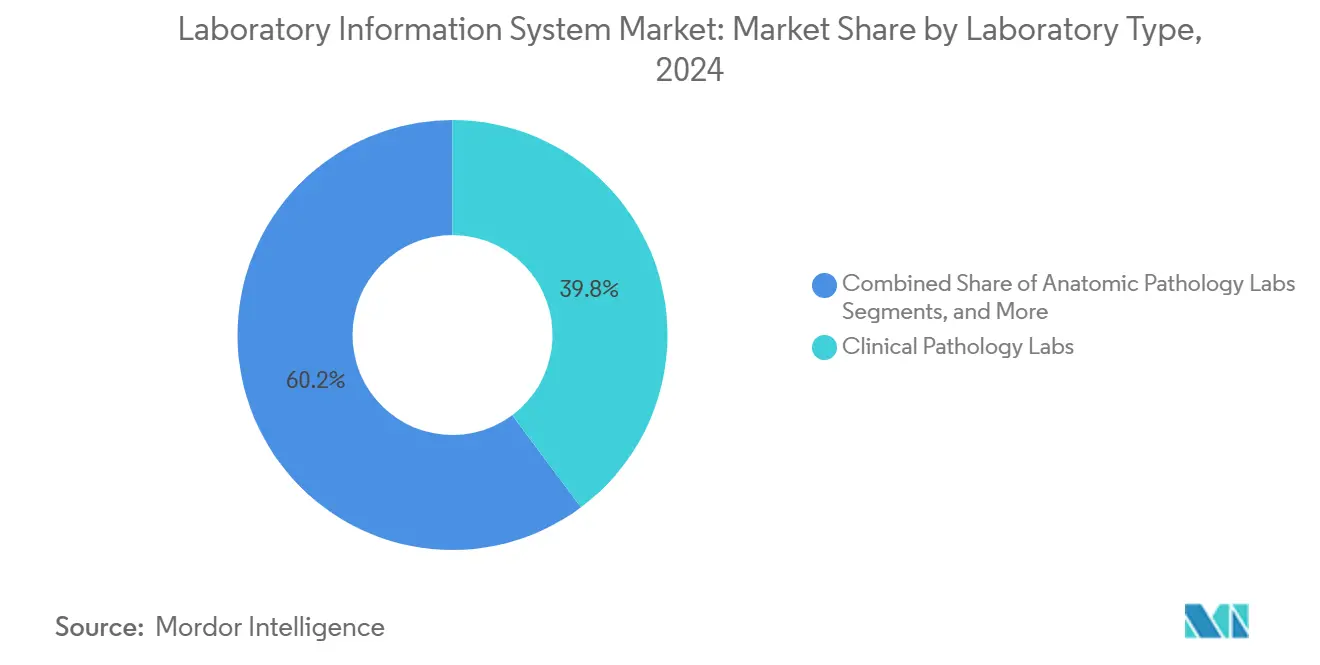
Note: Segment shares of all individual segments available upon report purchase
By End User: Independent Laboratories Accelerate Growth
Hospitals and clinics kept 55.45% of 2024 revenue, benefiting from enterprise purchasing leverage and the imperative to marry laboratory data with electronic health records. Consolidation, however, propels independent reference networks to a 14.12% CAGR as regional players merge for scale. These networks require multi-site order routing, contract pricing engines, and courier fleet dispatch modules, enlarging the laboratory information system market to accommodate complex outreach models.
Outsourcing agreements mean hospital labs increasingly send esoteric assays to third-party centers, making real-time results exchange vital for coordinated care. Academic medical centers straddle clinical and research missions, demanding ELN integrations and grant-compliance reports on top of routine LIS output. Vendors capable of toggling between regulated diagnostic and investigational research modes inside one tenant environment capture this hybrid demand. Consequently, feature roadmaps add consent tracking, study blinding, and data-export governance to satisfy IRB scrutiny.
Geography Analysis
North America continued to dominate with 42.84% of the laboratory information system market share in 2024. The United States anchors this lead through strict CLIA oversight and robust payer incentives that reward digital quality metrics. Canada’s single-payer initiatives inject funding into provincial lab modernizations, while Mexico’s private-hospital chains adopt cloud platforms to bypass limited legacy IT staffing. The fallout from the 2024 Change Healthcare breach draws executive attention to cybersecurity hardening and vendor SOC 2 credentials. New FDA mandates for laboratory-developed tests, effective May 2025, push replacement cycles as older platforms lack the e-quality-management functions now required.
Asia-Pacific registers the fastest 14.38% CAGR, underwritten by government e-health roadmaps and expanding middle-class insurance coverage. India’s National Digital Health Blueprint funnels investment into interoperable data platforms, and early pilots forecast a USD 25 billion digital-health economy by 2030. China’s rural health kiosks prove that tele-pathology and remote result delivery can leapfrog brick-and-mortar constraints, driving cloud adoption among tier-3 county hospitals. South Korea’s Samsung Medical Centre demonstrates smart-hospital orchestration where LIS, radiology, and pharmacy platforms align through FHIR exchanges, setting a regional benchmark copied by Singapore and Australia.
Europe shows steady though slower progression as GDPR dictates tight data-sovereignty controls that complicate extra-regional cloud hosting. Germany retains top regional share, while France accelerates oncology-focused sequencing labs benefiting from national genomics funding. The Middle East opens green-field hospital builds tied to Vision 2030 programs, embedding LIS from day one to meet Joint Commission accreditation. South America advances gradually; Brazil’s private insurance market encourages lab consolidation, yet currency volatility and regulatory heterogeneity temper multicountry deployments. Across all regions, donor-funded public-health labs seek open-source or low-cost SaaS options that comply with WHO surveillance reporting, creating a secondary tier for value-oriented vendors.
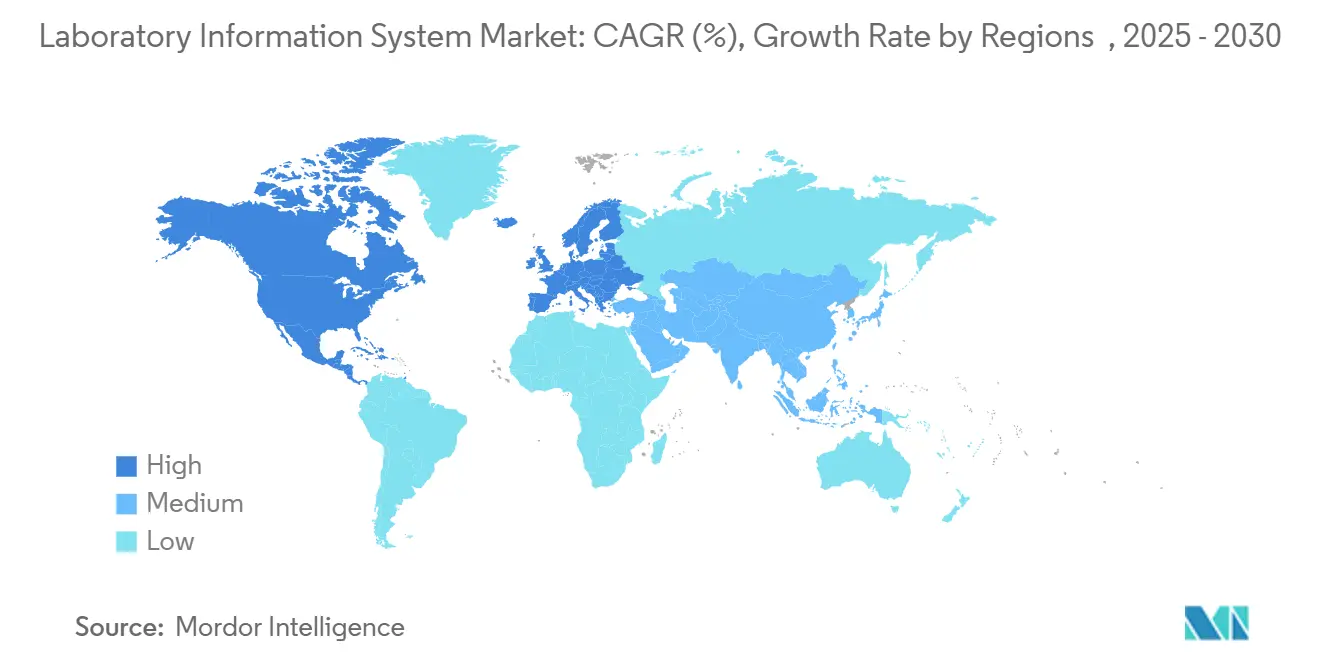
Competitive Landscape
The laboratory information system market remains moderately fragmented,, while dozens of specialists target niche workflows. Established players—Oracle Health (Cerner), Sunquest, and Epic—leverage entrenched footprints among large hospital systems, bundling LIS into broader clinical suites. Yet cloud-native entrants such as Clinisys and OvDx secure wins by promising 30-day deployments, elastic scaling, and consumption-based billing. AI-centric startups supply bolt-on modules for autoverification and image analytics, partnering with legacy vendors that prefer to buy rather than build.
Strategic acquisitions intensify. Quest Diagnostics’ USD 985 million purchase of LifeLabs in July 2024 expanded its Canadian presence and cross-border test-routing network. LabVantage merged with Biomax Informatics in October 2024 to embed bioinformatics inside its LIMS core, appealing to molecular diagnostics clients. Vendors emphasize regulatory prowess as the May 2025 FDA LDT rule looms: platforms now ship built-in design-control records, CAP checklist mappings, and e-signature audit layers. Cybersecurity posture also differentiates bids; SOC 2 Type II certificates and managed detection services become gating requirements on RFP shortlists.
Pricing models evolve. Legacy perpetual licenses transition toward SaaS subscriptions to align with budget cycles. Implementation accelerators—pre-configured interfaces to hematology, chemistry, and middleware analyzers—shrink project durations from nine months to as few as twelve weeks. Competitive positioning thus hinges on three axes: time-to-value, AI-enabled efficiency gains, and end-to-end compliance scaffolding. Vendors unable to demonstrate tangible turnaround-time or cost-per-test reductions risk relegation to low-growth maintenance contracts.
Global Laboratory Information System Industry Leaders
-
Roper Technologies (Sunquest Information Systems, Inc)
-
XIFIN Inc
-
Cerner Corporation
-
Orchard Software Corporation
-
Sysmex Corporation
- *Disclaimer: Major Players sorted in no particular order
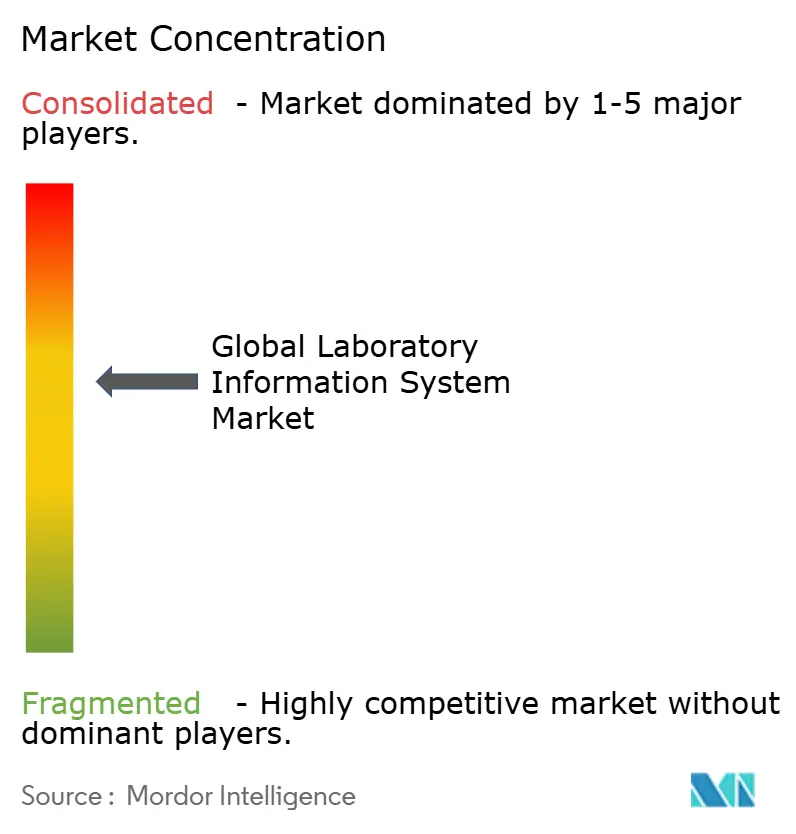
Recent Industry Developments
- October 2024: LabVantage Solutions and Biomax Informatics merged to integrate LIMS and bioinformatics capabilities for life-science and biomanufacturing customers.
- February 2022: Roche Diagnostics partnered with Sanomede Medical Technology to launch RS600 Lab Automation Software for the Chinese market.
- February 2022: Biosero, a BICO company, released new Green Button Go software features to streamline automated lab workflows.
Research Methodology Framework and Report Scope
Market Definitions and Key Coverage
Our study defines the laboratory information system (LIS) market as global revenue generated from software platforms and related services that handle sample accessioning, test ordering, result validation, and data exchange inside clinical, anatomic, and molecular pathology laboratories. The scope embraces on-premise, cloud, and hybrid deployments used by hospitals, independent labs, blood banks, and biobanks, and all values are expressed in constant 2025 USD.
Scope Exclusions: Solutions limited to research-only LIMS, electronic lab notebooks, middleware interface boxes, or hardware sales are out of scope.
Segmentation Overview
- By Component
- Software
- Stand-alone LIS
- Integrated LIS / EHR-centric
- SaaS LIS Platforms
- Services
- Implementation & Integration
- Maintenance & Support
- Training & Consulting
- Software
- By Mode of Delivery
- On-premise
- Cloud-based
- Hybrid
- By Laboratory Type
- Clinical Pathology Labs
- Anatomic Pathology Labs
- Molecular Diagnostics Labs
- Blood Banks & Biobanks
- Other Specialized Labs
- By End User
- Hospitals & Clinics
- Laboratories
- Academic & Research Institutes
- By Geography
- North America
- United States
- Canada
- Mexico
- Europe
- Germany
- United Kingdom
- France
- Italy
- Spain
- Rest of Europe
- Asia-Pacific
- China
- Japan
- India
- Australia
- South Korea
- Rest of Asia-Pacific
- Middle East & Africa
- GCC
- South Africa
- Rest of Middle East & Africa
- South America
- Brazil
- Argentina
- Rest of South America
- North America
Detailed Research Methodology and Data Validation
Primary Research
Mordor analysts interview LIS administrators, pathologists, hospital IT directors, and regional integrators across North America, Europe, Asia-Pacific, Latin America, and the Middle East. These conversations refine average workstation counts, cloud migration speeds, refresh intervals, and discounting practices, closing gaps flagged during desk review.
Desk Research
We start by extracting test-volume trends, laboratory counts, and health-IT spending from tier-one public sources such as WHO, CDC, Eurostat, and OECD. Trade briefs from the College of American Pathologists and the European Federation of Clinical Chemistry reveal accreditation rates and digitization mandates, while 10-Ks of in-vitro diagnostic vendors clarify interface pricing. Patent analytics pulled through Questel highlight refresh cycles, and news wires on Dow Jones Factiva plus company records on D&B Hoovers track expansion moves. The sources listed illustrate key inputs; many additional documents underpin interim validations.
Market-Sizing & Forecasting
Our top-down build links global test volumes and lab density to typical LIS penetration and mean annual spend per workstation. Supplier roll-ups from sampled contracts act as a bottom-up checkpoint before results are reconciled. Key model drivers include inpatient test mix, interoperability deadlines, enterprise consolidation, cloud price erosion, and currency shifts. Multivariate regression coupled with scenario analysis extends each driver through 2030, while missing inputs are imputed from vetted regional analogs.
Data Validation & Update Cycle
Outputs pass two analyst reviews, then anomalies are screened against independent series such as healthcare IT outlays and pathology staffing ratios. Reports refresh annually, with unscheduled updates triggered by material events like landmark reimbursement changes.
Why Mordor's Laboratory Information System Baseline Earns Trust
Published estimates often diverge because firms adopt different functional scopes, deployment mixes, and refresh cadences. By clarifying these choices up front, we help buyers understand exactly what our 2025 figure represents.
Key gap drivers include whether LIMS revenues are blended, the aggressiveness of cloud price deflation, and whether service renewal fees are annualized or capitalized. Mordor reports only pure-play LIS revenue and applies realized ASP erosion captured from live bids, producing a realistic baseline.
Benchmark comparison
| Market Size | Anonymized source | Primary gap driver |
|---|---|---|
| USD 3.94 Bn (2025) | Mordor Intelligence | - |
| USD 2.18 Bn (2024) | Global Consultancy A | Omits enterprise-wide service contracts and specialty labs |
| USD 3.30 Bn (2024) | Trade Journal B | Blends LIMS with LIS and uses list prices |
| USD 2.73 Bn (2025) | Industry Association C | Applies conservative penetration ratios and older FX rates |
In sum, Mordor's disciplined scope choices, live pricing checks, and annual refresh cycle give decision-makers a transparent, balanced baseline that is traceable to verifiable laboratory metrics.
Key Questions Answered in the Report
How big is the Global Laboratory Information System Market?
The Global Laboratory Information System Market size is expected to reach USD 3.94 billion in 2025 and grow at a CAGR of 12.79% to reach USD 7.19 billion by 2030.
Which deployment model is growing fastest?
Cloud-based laboratory information system market contracts are projected to post a 13.85% CAGR through 2030 as laboratories shift from capital expenditure to subscription plans.
Who are the key players in Global Laboratory Information System Market?
Roper Technologies (Sunquest Information Systems, Inc), XIFIN Inc, Cerner Corporation, Orchard Software Corporation and Sysmex Corporation are the major companies operating in the Global Laboratory Information System Market.
Which is the fastest growing region in Global Laboratory Information System Market?
Asia-Pacific leads with a forecast 14.38% CAGR due to government digitization drives, expanding healthcare access, and readiness to adopt cloud-native LIS solutions.
Which region has the biggest share in Global Laboratory Information System Market?
In 2025, the North America accounts for the largest market share in Global Laboratory Information System Market.
Page last updated on:
